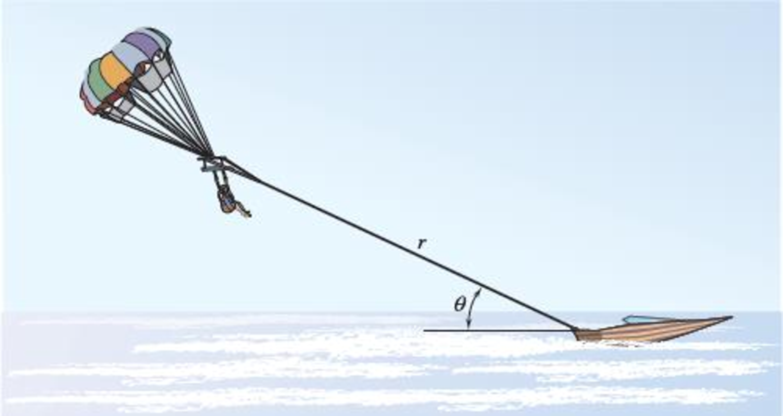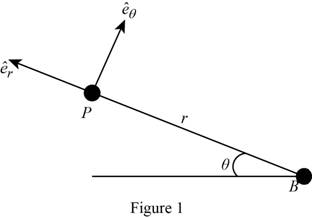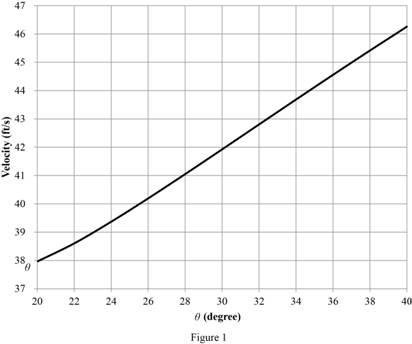
Concept explainers
Some parasailing systems use a winch to pull the rider back to the boat. During the interval when θ is between 20° and 40° (where t = 0 at θ = 20°), the angle increases at the constant rate of 2°/s. During this time, the length of the rope is defined by the relationship
Fig. P11.163 and P11.164

(a)
Plot the magnitude of the velocity of the parasailer as a function of time.
Explanation of Solution
Given Information:
During the interval the
The angle
The length of the rope is define by the relationship (r) of
The boat is travelling at a constant velocity
Calculation:
Convert the knot to feet per second.
Consider
Show the Free body diagram of parasailer and boat as in Figure (1).

Write the velocity
The acceleration vector of the boat is as follows:
Differentiate angle
Differentiate radius (r) with respective to time (t).
Differentiate
Write the expression for velocity vector
Here,
Write the expression for acceleration vector
Here,
Write the velocity vector
Write the acceleration vector
Write the velocity vector
Substitute
Calculate velocity vector of parasailer at an angle
Substitute 0 for t,
Here,
Calculate the velocity
Substitute
The time (t) is increase with 1 sec for an angle of
Similarly, calculate the velocity
Summarize the calculated values of velocity as in Table (1).
|
Time(t) (sec) | Radius (r) | |||||
| 0 | 20 | 600.000 | 0.000 | 32.463 | 19.681 | 37.963 |
| 1 | 22 | 599.875 | -0.313 | 33.434 | 19.298 | 38.603 |
| 2 | 24 | 599.293 | -0.884 | 34.616 | 18.751 | 39.369 |
| 3 | 26 | 598.051 | -1.624 | 35.911 | 18.051 | 40.193 |
| 4 | 28 | 596.000 | -2.500 | 37.274 | 17.195 | 41.050 |
| 5 | 30 | 593.012 | -3.494 | 38.676 | 16.180 | 41.924 |
| 6 | 32 | 588.977 | -4.593 | 40.090 | 15.001 | 42.804 |
| 7 | 34 | 583.795 | -5.788 | 41.494 | 13.658 | 43.684 |
| 8 | 36 | 577.373 | -7.071 | 42.867 | 12.149 | 44.555 |
| 9 | 38 | 569.625 | -8.438 | 44.190 | 10.474 | 45.415 |
| 10 | 40 | 560.472 | -9.882 | 45.446 | 8.635 | 46.259 |
Plot the magnitude of the velocity of the parasailer as a function of time as in Figure (1).

(a)
The magnitude of the acceleration
Answer to Problem 11.164P
The magnitude of the acceleration
Explanation of Solution
Given Information:
During the interval the
The angle
The length of the rope is define by the relationship (r) of
The boat is travelling at a constant velocity
Calculation:
Write the expression for acceleration vector
Substitute
Calculate the acceleration vector
Substitute 5 sec for t,
Here,
Calculate the acceleration
Substitute
Therefore, the magnitude of the acceleration
Want to see more full solutions like this?
Chapter 11 Solutions
Vector Mechanics for Engineers: Statics and Dynamics
- two automobiles A and B are approaching each other in adjacent highway lanes. at t=0, A and B are 3200ft apart. Their speeds are Va= 65 mi/h and Vb= 40 mi/h, and they are at points P and Q, respectively. knowing that A passes point Q 40s after B was there and that B passes point P 42s after A was there: A) determine the speed of B at the moment that it passes A in ft/s B.) when the vehicles pass each other in seconds C.) uniform acceleration of B in ft/s^2arrow_forwardIn a boat race , boat A is leading boat B by 41.2m and both boats are travelling at a constant speed of 123.7 kph. At t=0, the boats accelerate at constant rates. Knowing that when B passes A, t=8s and boat A is moving at 220.4 kph, determine the velocity (m/s) of B relative to A at the time when B passes A. Round off only on the final answer expressed in 3 decimal places.arrow_forwardA stone A is dropped from rest down a well, and at time t1 another stone B is dropped from rest. Determine the time interval between the instant A strikes the water and the instant B strikes the water. Also, at what speed do they strike the water? Given: d = 80 m t1 = 1 s g = 9.81 m/S2arrow_forward
- In anticipation of a long 7° upgrade, a bus driver accelerates at a constant rate of 3 ft/s2 while still on a level section of the highway. Knowing that the speed of the bus is 60 mi/h as it begins to climb the grade and that the driver does not change the setting of his throttle or shift gears, determine the distance traveled by the bus up the grade when its speed has decreased to 50 mi/h.arrow_forwardCar A is traveling at 40 mi/h when it enters a 30 mi/h speed zone. The driver of car A decelerates at a rate of 16 ft/s2 until reaching a speed of 30 mi/h, which she then maintains. When car B , which was initially 60 ft behind car A and traveling at a constant speed of 45 mi/h, enters the speed zone, its driver decelerates at a rate of 20 ft/s2 until reaching a speed of 28 mi/h. Knowing that the driver of car B maintains a speed of 28 mi/h, determine (a) the closest that car B comes to car A, (b) the time at which car A is 70 ft in front of car B.arrow_forwardA loaded railroad car is rolling at a constant velocity when it couples with a spring and dashpot bumper system. After the coupling, the motion of the car is defined by the relation 4.8 60 sin16 t xe t − = where x and t are expressed in mm and seconds, respectively. Determine the position, the velocity and the acceleration of the railroad car when (a) t = 0, (b) t = 0.3 s.arrow_forward
- In a boat race , boat A is leading boat B by 45.8m and both boats are travelling at a constant speed of 135 kph. At t=0, the boats accelerate at constant rates. Knowing that when B passes A, t=8s and boat A is moving at 236.2 kph, determine the relative position (m) of B with respect to A at 13s. Round off only on the final answer expressed in 3 decimal places.arrow_forwardThe motion of a vibrating particle is defined by the position vector r= (4 sin πt) i- (cos 2πt)j, where r is expressed in inches and t in seconds. (a ) Determine the velocity and acceleration when t = 1 s. (b) Show that the path of the particle is parabolic.arrow_forwardThe 3-kg collar B slides on the frictionless arm AA’. The arm is attached to drum D and rotates about O in a horizontal plane at the rate 0=0.75t, where 0 and t are expressed in rad/s and seconds, respectively. As the arm-drum assembly rotates, a mechanism within the drum releases cord so that the collar moves outward from O with a constant speed of 0.5 m/s. Knowing that at t= 0, r= 0, determine the time at which the tension in the cord is equal to the magnitude of the horizontal force exerted on B by arm AA,.arrow_forward
- A satellite will travel indefinitely in a circular orbit around a planet if the normal component of the acceleration of the satellite is equal to g(R/r)2, where g is the acceleration of gravity at the surface of the planet, R is the radius of the planet, and r is the distance from the center of the planet to the satellite. Knowing that the diameter of the sun is 1.39 Gm and that the acceleration of gravity at its surface is 274 m/s2, determine the radius of the orbit of the indicated planet around the sun assuming that the orbit is circular.arrow_forward-Car A moving at a constant velocity of 25 m/sec passes a gasoline station. At the same instant, car B leaves the same gasoline station and travels the same direction as that of car A. Determine the required acceleration of car B in order to overtake car A after 35 seconds. -Two cars A and B are travelling in the same direction with a velocity of 30 m/sec. Car A is 250 meters behind car B. After 17 seconds, car B decelerates at a constant rate. Determine the deceleration of car B so that car A can overtake after 17 seconds.arrow_forwardA group of students launches a model rocket in the vertical direction. Based on tracking data, they determine that the altitude of the rocket was 89.6 ft at the end of the powered portion of the flight and that the rocket landed 18.5 s later. The descent parachute failed to deploy so that the rocket fell freely to the ground after reaching its maximum altitude. Assume that g = 32.2 ft/s2. Determine the speed v1 of the rocket at the end of powered flight. The speed is ____ ft/s.arrow_forward
 Elements Of ElectromagneticsMechanical EngineeringISBN:9780190698614Author:Sadiku, Matthew N. O.Publisher:Oxford University Press
Elements Of ElectromagneticsMechanical EngineeringISBN:9780190698614Author:Sadiku, Matthew N. O.Publisher:Oxford University Press Mechanics of Materials (10th Edition)Mechanical EngineeringISBN:9780134319650Author:Russell C. HibbelerPublisher:PEARSON
Mechanics of Materials (10th Edition)Mechanical EngineeringISBN:9780134319650Author:Russell C. HibbelerPublisher:PEARSON Thermodynamics: An Engineering ApproachMechanical EngineeringISBN:9781259822674Author:Yunus A. Cengel Dr., Michael A. BolesPublisher:McGraw-Hill Education
Thermodynamics: An Engineering ApproachMechanical EngineeringISBN:9781259822674Author:Yunus A. Cengel Dr., Michael A. BolesPublisher:McGraw-Hill Education Control Systems EngineeringMechanical EngineeringISBN:9781118170519Author:Norman S. NisePublisher:WILEY
Control Systems EngineeringMechanical EngineeringISBN:9781118170519Author:Norman S. NisePublisher:WILEY Mechanics of Materials (MindTap Course List)Mechanical EngineeringISBN:9781337093347Author:Barry J. Goodno, James M. GerePublisher:Cengage Learning
Mechanics of Materials (MindTap Course List)Mechanical EngineeringISBN:9781337093347Author:Barry J. Goodno, James M. GerePublisher:Cengage Learning Engineering Mechanics: StaticsMechanical EngineeringISBN:9781118807330Author:James L. Meriam, L. G. Kraige, J. N. BoltonPublisher:WILEY
Engineering Mechanics: StaticsMechanical EngineeringISBN:9781118807330Author:James L. Meriam, L. G. Kraige, J. N. BoltonPublisher:WILEY





